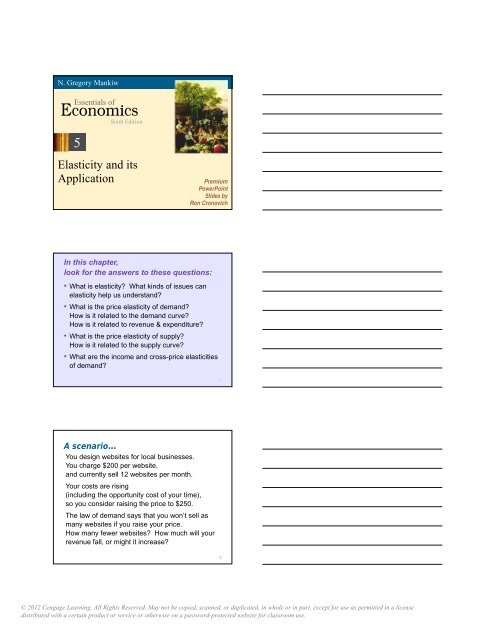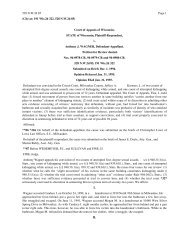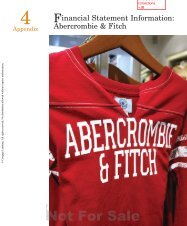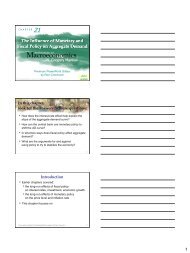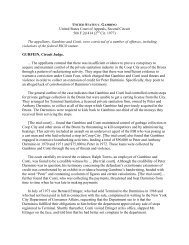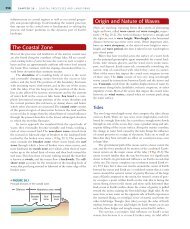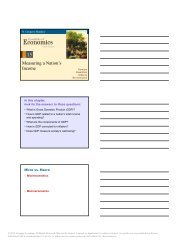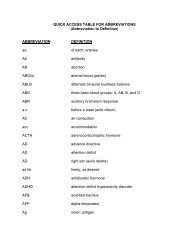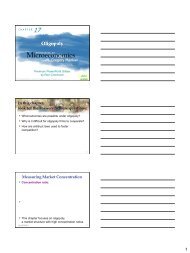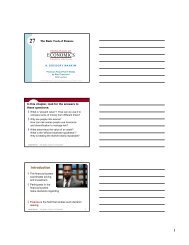Economics - Cengage Learning
Economics - Cengage Learning
Economics - Cengage Learning
Create successful ePaper yourself
Turn your PDF publications into a flip-book with our unique Google optimized e-Paper software.
N. Gregory Mankiw<br />
Essentials of<br />
<strong>Economics</strong><br />
Sixth Edition<br />
5<br />
Elasticity and its<br />
Application Premium<br />
PowerPoint<br />
Slides by<br />
Ron Cronovich<br />
In this chapter,<br />
look for the answers to these questions:<br />
• What is elasticity? What kinds of issues can<br />
elasticity help us understand?<br />
• What is the price elasticity of demand?<br />
How is it related to the demand curve?<br />
How is it related to revenue & expenditure?<br />
• What is the price elasticity of supply?<br />
How is it related to the supply curve?<br />
• What are the income and cross-price elasticities<br />
of demand?<br />
A scenario…<br />
You design websites for local businesses.<br />
You charge $200 per website,<br />
and currently sell 12 websites per month.<br />
Your costs are rising<br />
(including the opportunity cost of your time),<br />
so you consider raising the price to $250.<br />
The law of demand says that you won’t sell as<br />
many websites if you raise your price.<br />
How many fewer websites? How much will your<br />
revenue fall, or might it increase?<br />
© 2012 <strong>Cengage</strong><strong>Learning</strong>. All Rights Reserved. May not be copied, scanned, or duplicated, in whole or in part, except for use as permitted in alicense<br />
distributed with a certain product or service or otherwise on a password-protected website for classroom use.<br />
1<br />
22
Elasticity<br />
§ Basic idea:<br />
§ One type of elasticity measures how much<br />
demand for your websites will fall if you raise<br />
your price.<br />
§ Definition:<br />
Elasticity is<br />
Price Elasticity of Demand<br />
Price elasticity<br />
of demand<br />
§ Price elasticity of demand measures<br />
§ Loosely speaking, it measures<br />
Price Elasticity of Demand<br />
Example:<br />
Price elasticity<br />
of demand<br />
equals<br />
=<br />
P<br />
D<br />
© 2012 <strong>Cengage</strong><strong>Learning</strong>. All Rights Reserved. May not be copied, scanned, or duplicated, in whole or in part, except for use as permitted in alicense<br />
distributed with a certain product or service or otherwise on a password-protected website for classroom use.<br />
3<br />
4<br />
Q<br />
5
Price Elasticity of Demand<br />
Along a D curve, P and Q move in opposite<br />
directions, which would make price elasticity<br />
negative.<br />
We will drop the minus sign and report all price<br />
elasticities as positive numbers.<br />
Calculating Percentage Changes<br />
$250<br />
$200<br />
P<br />
Demand for<br />
your websites<br />
8<br />
B<br />
12<br />
A<br />
D<br />
Q<br />
Standard method<br />
of computing the<br />
percentage (%) change:<br />
end value – start value<br />
start value<br />
© 2012 <strong>Cengage</strong><strong>Learning</strong>. All Rights Reserved. May not be copied, scanned, or duplicated, in whole or in part, except for use as permitted in alicense<br />
distributed with a certain product or service or otherwise on a password-protected website for classroom use.<br />
6<br />
x 100%<br />
Going from A to B,<br />
the % change in P equals<br />
($250–$200)/$200 = 25%<br />
Calculating Percentage Changes<br />
$250<br />
$200<br />
P<br />
Demand for<br />
your websites<br />
8<br />
B<br />
12<br />
A<br />
D<br />
Q<br />
Problem:<br />
From A to B,<br />
P rises 25%, Q falls 33%,<br />
elasticity = 33/25 = 1.33<br />
From B to A,<br />
P falls 20%, Q rises 50%,<br />
elasticity = 50/20 = 2.50<br />
7<br />
8
Calculating Percentage Changes<br />
§ So, we instead use the midpoint method:<br />
§ The midpoint is<br />
§ It doesn’t matter which value you use as the<br />
start and which as the end—you get the same<br />
answer either way!<br />
Calculating Percentage Changes<br />
§ Using the midpoint method, the % change<br />
in P equals<br />
§ The % change in Q equals<br />
§ The price elasticity of demand equals<br />
ACTIVE LEARNING 1<br />
Calculate an elasticity<br />
Use the following<br />
information to<br />
calculate the<br />
price elasticity<br />
of demand<br />
for hotel rooms:<br />
if P = $70, Q d = 5000<br />
if P = $90, Q d = 3000<br />
© 2012 <strong>Cengage</strong><strong>Learning</strong>. All Rights Reserved. May not be copied, scanned, or duplicated, in whole or in part, except for use as permitted in alicense<br />
distributed with a certain product or service or otherwise on a password-protected website for classroom use.<br />
9<br />
10
What determines price elasticity?<br />
To learn the determinants of price elasticity,<br />
we look at a series of examples.<br />
Each compares two common goods.<br />
In each example:<br />
§ Suppose the prices of both goods rise by 20%.<br />
§ The good for which Q d falls the most (in percent)<br />
has the highest price elasticity of demand.<br />
Which good is it? Why?<br />
§ What lesson does the example teach us about the<br />
determinants of the price elasticity of demand?<br />
EXAMPLE 1:<br />
Breakfast Cereal vs. Sunscreen<br />
§ The prices of both of these goods rise by 20%.<br />
For which good does Q d drop the most? Why?<br />
§ Lesson:<br />
EXAMPLE 2:<br />
“Blue Jeans” vs. “Clothing”<br />
§ The prices of both goods rise by 20%.<br />
For which good does Q d drop the most? Why?<br />
§ Lesson:<br />
13<br />
14<br />
15<br />
© 2012 <strong>Cengage</strong><strong>Learning</strong>. All Rights Reserved. May not be copied, scanned, or duplicated, in whole or in part, except for use as permitted in alicense<br />
distributed with a certain product or service or otherwise on a password-protected website for classroom use.
EXAMPLE 3:<br />
Insulin vs. Caribbean Cruises<br />
§ The prices of both of these goods rise by 20%.<br />
For which good does Q d drop the most? Why?<br />
§ Lesson:<br />
EXAMPLE 4:<br />
Gasoline in the Short Run vs.<br />
Gasoline in the Long Run<br />
§ The price of gasoline rises 20%. Does Q d drop<br />
more in the short run or the long run? Why?<br />
§ Lesson:<br />
The Determinants of Price Elasticity:<br />
A Summary<br />
The price elasticity of demand depends on:<br />
16<br />
17<br />
18<br />
© 2012 <strong>Cengage</strong><strong>Learning</strong>. All Rights Reserved. May not be copied, scanned, or duplicated, in whole or in part, except for use as permitted in alicense<br />
distributed with a certain product or service or otherwise on a password-protected website for classroom use.
The Variety of Demand Curves<br />
§ The price elasticity of demand is closely related<br />
to the slope of the demand curve.<br />
§ Rule of thumb:<br />
§ Five different classifications of D curves.…<br />
“Perfectly inelastic demand” (one extreme case)<br />
Price elasticity<br />
of demand<br />
D curve:<br />
Consumers’<br />
price sensitivity:<br />
Elasticity:<br />
“Inelastic demand”<br />
Price elasticity<br />
of demand<br />
D curve:<br />
Consumers’<br />
price sensitivity:<br />
Elasticity:<br />
= % change in Q<br />
% change in P =<br />
P 1<br />
P<br />
= % change in Q<br />
% change in P =<br />
P 1<br />
P<br />
D<br />
Q 1<br />
Q 1<br />
D<br />
Q<br />
Q<br />
19<br />
20<br />
21<br />
© 2012 <strong>Cengage</strong><strong>Learning</strong>. All Rights Reserved. May not be copied, scanned, or duplicated, in whole or in part, except for use as permitted in alicense<br />
distributed with a certain product or service or otherwise on a password-protected website for classroom use.
“Unit elastic demand”<br />
Price elasticity<br />
of demand<br />
D curve:<br />
Consumers’<br />
price sensitivity:<br />
Elasticity:<br />
“Elastic demand”<br />
Price elasticity<br />
of demand<br />
D curve:<br />
Consumers’<br />
price sensitivity:<br />
Elasticity:<br />
= % change in Q<br />
% change in P =<br />
P 1<br />
P<br />
= % change in Q<br />
% change in P =<br />
“Perfectly elastic demand” (the other extreme)<br />
Price elasticity<br />
of demand<br />
D curve:<br />
Consumers’<br />
price sensitivity:<br />
Elasticity:<br />
P 1<br />
P<br />
= % change in Q<br />
% change in P =<br />
P2 = P1 P<br />
Q 1<br />
Q 1<br />
Q 1<br />
D<br />
D<br />
D<br />
Q<br />
Q<br />
Q<br />
22<br />
23<br />
24<br />
© 2012 <strong>Cengage</strong><strong>Learning</strong>. All Rights Reserved. May not be copied, scanned, or duplicated, in whole or in part, except for use as permitted in alicense<br />
distributed with a certain product or service or otherwise on a password-protected website for classroom use.
A few elasticities from the real world<br />
Eggs 0.1<br />
Healthcare 0.2<br />
Rice 0.5<br />
Housing 0.7<br />
Beef 1.6<br />
Restaurant meals 2.3<br />
Mountain Dew 4.4<br />
Elasticity of a Linear Demand Curve<br />
$30<br />
20<br />
10<br />
P<br />
$0 0 20 40 60<br />
Q<br />
The slope<br />
of a linear<br />
demand<br />
curve is<br />
constant,<br />
but its<br />
elasticity<br />
is not.<br />
Price Elasticity and Total Revenue<br />
§ Continuing our scenario, if you raise your price<br />
from $200 to $250, would your revenue rise or fall?<br />
Revenue = P x Q<br />
§ A price increase has two effects on revenue:<br />
§ Which of these two effects is bigger?<br />
It depends on the price elasticity of demand.<br />
25<br />
26<br />
27<br />
© 2012 <strong>Cengage</strong><strong>Learning</strong>. All Rights Reserved. May not be copied, scanned, or duplicated, in whole or in part, except for use as permitted in alicense<br />
distributed with a certain product or service or otherwise on a password-protected website for classroom use.
Price Elasticity and Total Revenue<br />
Price elasticity<br />
of demand<br />
§ If demand is elastic, then<br />
= Percentage change in Q<br />
Percentage change in P<br />
Revenue = P x Q<br />
Price Elasticity and Total Revenue<br />
Elastic demand<br />
(elasticity = 1.8) P<br />
If P = $200,<br />
Q = 12 and<br />
revenue = ______<br />
If P = $250,<br />
Q = 8 and<br />
revenue = ______<br />
$250<br />
$200<br />
When D is elastic,<br />
a price increase<br />
causes revenue to __________.<br />
Demand for<br />
your websites<br />
Price Elasticity and Total Revenue<br />
Price elasticity<br />
of demand<br />
§ If demand is inelastic, then<br />
= Percentage change in Q<br />
8<br />
12<br />
Percentage change in P<br />
Revenue = P x Q<br />
§ In our example, suppose that Q only falls to 10<br />
(instead of 8) when you raise your price to $250.<br />
D<br />
Q<br />
28<br />
29<br />
30<br />
© 2012 <strong>Cengage</strong><strong>Learning</strong>. All Rights Reserved. May not be copied, scanned, or duplicated, in whole or in part, except for use as permitted in alicense<br />
distributed with a certain product or service or otherwise on a password-protected website for classroom use.
Price Elasticity and Total Revenue<br />
Now, demand is<br />
inelastic:<br />
elasticity = 0.82 P<br />
If P = $200,<br />
Q = 12 and<br />
revenue = ________ $250<br />
If P = $250,<br />
Q = 10 and<br />
revenue = ________<br />
$200<br />
When D is inelastic,<br />
a price increase<br />
causes revenue to _________.<br />
Demand for<br />
your websites<br />
ACTIVE LEARNING 2<br />
Elasticity and expenditure/revenue<br />
A. Pharmacies raise the price of insulin by 10%.<br />
Does total expenditure on insulin rise or fall?<br />
B. As a result of a fare war, the price of a luxury<br />
cruise falls 20%.<br />
Does luxury cruise companies’ total revenue<br />
rise or fall?<br />
ACTIVE LEARNING 2<br />
Answers<br />
10<br />
12<br />
D<br />
Q<br />
31<br />
© 2012 <strong>Cengage</strong><strong>Learning</strong>. All Rights Reserved. May not be copied, scanned, or duplicated, in whole or in part, except for use as permitted in alicense<br />
distributed with a certain product or service or otherwise on a password-protected website for classroom use.
APPLICATION: Does Drug Interdiction Increase<br />
or Decrease Drug-Related Crime?<br />
§ One side effect of illegal drug use is crime:<br />
Users often turn to crime to finance their habit.<br />
§ We examine two policies designed to reduce<br />
illegal drug use and see what effects they have<br />
on drug-related crime.<br />
§ For simplicity, we assume the total dollar value<br />
of drug-related crime equals total expenditure<br />
on drugs.<br />
§ Demand for illegal drugs is inelastic, due to<br />
addiction issues.<br />
Policy 1: Interdiction<br />
Interdiction<br />
reduces<br />
the supply<br />
of drugs.<br />
Since demand<br />
for drugs is<br />
inelastic,<br />
Result:<br />
Price of<br />
Drugs<br />
P 1<br />
Policy 2: Education<br />
Education<br />
reduces the<br />
demand for<br />
drugs.<br />
Result:<br />
Price of<br />
Drugs<br />
P 1<br />
D 1<br />
D 1<br />
Q 1<br />
Q 1<br />
S 1<br />
35<br />
Quantity<br />
of Drugs<br />
S<br />
36<br />
Quantity<br />
of Drugs<br />
37<br />
© 2012 <strong>Cengage</strong><strong>Learning</strong>. All Rights Reserved. May not be copied, scanned, or duplicated, in whole or in part, except for use as permitted in alicense<br />
distributed with a certain product or service or otherwise on a password-protected website for classroom use.
Price Elasticity of Supply<br />
Price elasticity<br />
of supply<br />
§ Price elasticity of supply measures<br />
§ Loosely speaking, it measures<br />
=<br />
§ Again, use the midpoint method to compute the<br />
percentage changes.<br />
Price Elasticity of Supply<br />
Example:<br />
Price<br />
elasticity<br />
of supply<br />
equals<br />
P 1<br />
The Variety of Supply Curves<br />
§ The slope of the supply curve is closely related<br />
to price elasticity of supply.<br />
§ Rule of thumb:<br />
§ Five different classifications…<br />
P<br />
Q 1<br />
S<br />
38<br />
Q<br />
39<br />
40<br />
© 2012 <strong>Cengage</strong><strong>Learning</strong>. All Rights Reserved. May not be copied, scanned, or duplicated, in whole or in part, except for use as permitted in alicense<br />
distributed with a certain product or service or otherwise on a password-protected website for classroom use.
“Perfectly inelastic” (one extreme)<br />
Price elasticity<br />
of supply<br />
S curve:<br />
Sellers’<br />
price sensitivity:<br />
Elasticity:<br />
“Inelastic”<br />
Price elasticity<br />
of supply<br />
S curve:<br />
Sellers’<br />
price sensitivity:<br />
Elasticity:<br />
= % change in Q<br />
= % change in Q<br />
“Unit elastic”<br />
Price elasticity<br />
of supply<br />
S curve:<br />
Sellers’<br />
price sensitivity:<br />
Elasticity:<br />
= % change in Q<br />
% change in P =<br />
P 1<br />
P 1<br />
P<br />
% change in P =<br />
P<br />
% change in P =<br />
P 1<br />
P<br />
S<br />
Q 1<br />
Q 1<br />
Q 1<br />
S<br />
S<br />
Q<br />
Q<br />
Q<br />
41<br />
42<br />
43<br />
© 2012 <strong>Cengage</strong><strong>Learning</strong>. All Rights Reserved. May not be copied, scanned, or duplicated, in whole or in part, except for use as permitted in alicense<br />
distributed with a certain product or service or otherwise on a password-protected website for classroom use.
“Elastic”<br />
Price elasticity<br />
of supply<br />
S curve:<br />
Sellers’<br />
price sensitivity:<br />
Elasticity:<br />
= % change in Q<br />
% change in P =<br />
P 1<br />
P<br />
Q 1<br />
“Perfectly elastic” (the other extreme)<br />
Price elasticity<br />
of supply<br />
S curve:<br />
Sellers’<br />
price sensitivity:<br />
Elasticity:<br />
§<br />
= % change in Q<br />
% change in P =<br />
P2 = P1 The Determinants of Supply Elasticity<br />
P<br />
Q 1<br />
§ Example: Supply of beachfront property is<br />
harder to vary and thus less elastic than<br />
supply of new cars.<br />
§ For many goods, price elasticity of supply<br />
is ________ in the long run than in the short run,<br />
because firms can build new factories,<br />
or new firms may be able to enter the market.<br />
S<br />
S<br />
Q<br />
Q<br />
44<br />
45<br />
46<br />
© 2012 <strong>Cengage</strong><strong>Learning</strong>. All Rights Reserved. May not be copied, scanned, or duplicated, in whole or in part, except for use as permitted in alicense<br />
distributed with a certain product or service or otherwise on a password-protected website for classroom use.
ACTIVE LEARNING 3<br />
Elasticity and changes in equilibrium<br />
§ The supply of beachfront property is inelastic.<br />
The supply of new cars is elastic.<br />
§ Suppose population growth causes<br />
demand for both goods to double<br />
(at each price, Q d doubles).<br />
§ For which product will P change the most?<br />
§ For which product will Q change the most?<br />
ACTIVE LEARNING 3<br />
Answers<br />
P<br />
ACTIVE LEARNING 3<br />
Answers<br />
P<br />
D 1 D 2<br />
D 1 D 2<br />
Beachfront property<br />
(inelastic supply):<br />
New cars<br />
(elastic supply):<br />
Q<br />
Q<br />
© 2012 <strong>Cengage</strong><strong>Learning</strong>. All Rights Reserved. May not be copied, scanned, or duplicated, in whole or in part, except for use as permitted in alicense<br />
distributed with a certain product or service or otherwise on a password-protected website for classroom use.
How the Price Elasticity of Supply Can Vary<br />
$15<br />
4<br />
$3<br />
12<br />
P<br />
100<br />
200<br />
Other Elasticities<br />
500<br />
S<br />
525<br />
§ Income elasticity of demand: measures<br />
Income elasticity<br />
of demand<br />
=<br />
§ Recall from Chapter 4: An increase in income<br />
causes an increase in demand for a normal good.<br />
§ Hence, for normal goods, income elasticity<br />
§ For inferior goods, income elasticity<br />
Other Elasticities<br />
§ Cross-price elasticity of demand: measures<br />
Cross-price elast.<br />
of demand<br />
=<br />
§ For substitutes, cross-price elasticity<br />
(e.g., an increase in price of beef causes an<br />
increase in demand for chicken)<br />
§ For complements, cross-price elasticity<br />
(e.g., an increase in price of computers causes<br />
decrease in demand for software)<br />
Q<br />
50<br />
51<br />
52<br />
© 2012 <strong>Cengage</strong><strong>Learning</strong>. All Rights Reserved. May not be copied, scanned, or duplicated, in whole or in part, except for use as permitted in alicense<br />
distributed with a certain product or service or otherwise on a password-protected website for classroom use.


